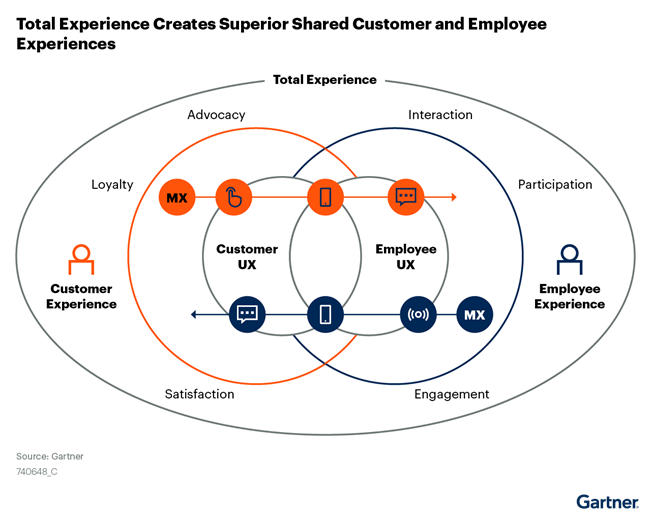In the report released in December 2020, titled ‘Top Strategic Technology Trends for 2021: Total Experience”, Gartner states that “Total Experience (TX) is a strategy that creates superior shared experiences by interlinking the multiexperience (MX), customer experience (CX), employee experience (EX) and user experience (UX) disciplines”.
User Experience (UX): “The singular or aggregated experiences that occur for users as a result of
interacting with a product in a given context. Common contributing factors
to a user experience include the product’s graphic design, interaction design
and content, both written and visual.”
Employee Experience (EX): “The employee’s perceptions and related feelings caused by the one-off and
cumulative effect of interactions with his or her employer’s customers,
partners, leaders, teams, processes, policies, tools and overall work
environment.”
Customer Experience (CX): “The customer’s perceptions and related feelings caused by the one-off and
cumulative effect of interactions with a supplier’s employees, systems,
channels or products.”
Multiexperience (MX): “The interaction across a variety of digital touchpoints (e.g., web, mobile
apps, chatbots, augmented reality/virtual reality, wearables), using a
combination of interaction modalities (e.g., touch, voice, vision, gesture) in
support of seamless and consistent digital user journeys.”
According to Gartner, “These intersected experiences are key business moments. They require organizations to rethink how they change behavior and technologies by addressing the feelings, emotions and memories that make up the CX and EX, as well as the experience of partners and other constituents.” Essentially, for a business to excel, one must consider how all four experiences interact and influence one another.

One strategy Gartner suggests employing is using value streams that “cut across siloed business capabilities to provide end-to-end visibility to the activity flow from customer request to delivery of goods or services.” By forming these value streams, organizations can build a connection between user values and the values of a company/product. Considering the values of both parties helps to tighten the relationship between Customer and Employee gained from an understanding of each parties’ needs and wants in respect to the product, service or interaction.
This is an excellent opportunity for the application of Emotion AI. The kama.ai Designed Emotional Intelligence® platform is built specifically to address the emotional experience of consumer interactions with your organization. Whether addressing customer requests for product information, a service complaint, or a question about using your product, kama DEI understands the nuances of language, emotions and human values with a patented conversational intelligence. The result is quicker access to the information your customers need driving higher customer experience scores, increased engagement, brand loyalty, and ultimately, higher business returns.
Furthermore, removing repetitive inquiry handling and even repetitive tasks through Robotic Process Automation enhances the employee experience allowing them to concentrate on higher value, more creative and problem analysis tasks that are more stimulating and rewarding. The kama DEI service is also multiaccess, allowing users to experience emotional, contextual conversations on various platforms such as web-based chatbots, mobile web apps, Facebook Messenger, and smart home systems like Amazon’s Alexa. kama DEI provides valuable benefits by augmenting the CX, EX, UX, and MX within your organization resulting in a Total Experience that will satisfy all that engage with your brand.
But you may wonder, is the market prepared for adaptation such an AI? The answer is absolutely. The market is rapidly expanding AI capabilities, with IBM’s Global AI Adoption Index stating that, “74% of companies are exploring or deploying AI”. Ultimately, automating customer service tracks is essential as businesses look to maximize the Total Experience.
It has also been found that users tend to buy products where their values align. “Eighty-three percent of Millennials say it’s important for the companies they buy from to align with their beliefs and values” according to the findings of 5W Public Relations.

Source: 5W Public Relations
Using an emotion AI service that aligns consumer values with the values of the brand and its products helps to strengthen the consumer-provider bond and encourages product and service adoption.
The path to success is clearly laid out, with Gartner stating, “By 2024, organizations providing a total experience will outperform competitors by 25% in satisfaction metrics for both customer and employee experience”. The market is leveraging emotion AI to help solidify positive outcomes in customer and employee experiences by ensuring the values of their customers are understood and acted on. Customers want to feel comfortable and validated when interacting with organizations, so now is the time to move towards satisfying those needs.
To get more information on how kama.ai uses emotional intelligence to help business enhance their total experience, visit kama.ai and begin a conversation with our virtual agent Kady.
Written Madeleine Kwan
Source:
Gartner, ‘Top Strategic Technology Trends for 2021’, Brian Burke, Frances Karamouzis, Gilbert van der Heiden, Arun Chandrasekaran, David Cearley, Bart Willemsen, Brent Stewart, Ramon Krikken, Jay Heiser, Erick Brethenoux, Jason Wong, Michael Chiu, Michelle Deurst, Don Scheibenreif, Manjunath Bhat, Tony Harvey, Nicole Sturgill, Laurie Shotton, Stephanie Stoudt-Hansen, Gene Alvarez, Dennis Gaughan, Andrew White, David Smith, Ed Anderson, David Wright, Yefim Natis, October 19, 2020
